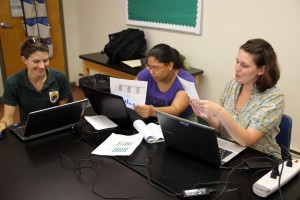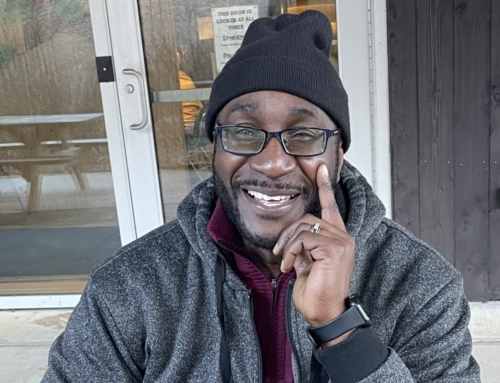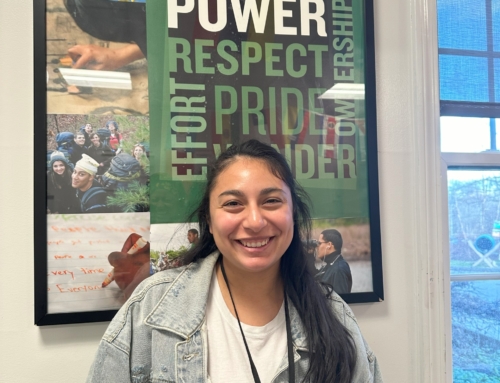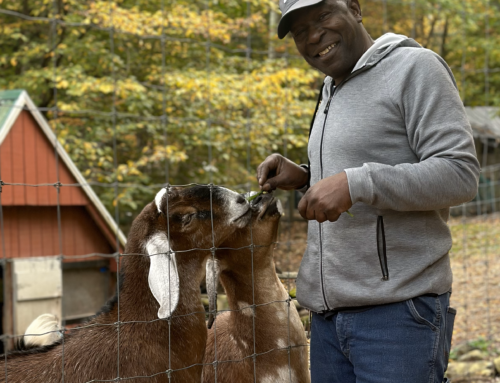by Melissa Spear, Executive Director; Liz Cox, School Director;
and Joel Tolman, Director of Impact & Engagement
Late in August — just as our diverse, powerful, hard-working students were arriving back at Common Ground — we received the results of last spring’s state-wide SBAC testing. Here is what we learned:
- Common Ground students performed just above the state average in math, and slightly below the state average in English/Language Arts. Statewide, 30.6% of 11th graders met or exceeded the bar set by the math test; at Common Ground, 31.3% did so. State-wide, 53.4% of students met or exceeded the achievement level in ELA; at Common Ground, 46.9% did so.
- We took a quick look at scores across the magnet, charter, and traditional public high schools serving students in Connecticut’s largest cities — Hartford, Bridgeport, New Haven, and Stamford — and Common Ground students did well compared to their peers at these schools. At the average school serving these cities, 20.7% of students met or exceeded standards in math, and 36.3% of students met or exceeded standards in English/Language Arts. This definitely is not a perfect comparison, but it does give us a sense of where we stand and where to focus our efforts — and also helps us identify schools from which Common Ground can learn.

The SBAC includes complex performance tasks that challenges students to apply multiple skills and concepts to real-world problems. This lines up with the kind of teaching Common Ground values, built around active, authentic tasks. Here, for instance, a Common Ground student works with staff from the U.S. Fish & Wildlife Service to write a science journal article sharing the results of insect monitoring at New Haven parks where our students have helped to restore habitat.
We think these results are important. At Common Ground, we have been planning for the arrival of SBAC for a long time. There are definitely flaws — too little attention to fiction on the SBAC and the Common Core standards on which the test is based, and a lot of technology infrastructure needed to administer tests, for instance.
But we think the SBAC tests things that actually matter. This test sets a much higher bar than the old CAPT test, and we like that. In particular, SBAC includes real performance tasks — applying skills and concepts to solve real world problems, synthesizing multiple points of view and sources, tackling open-ended challenges rather than ones with a single correct answer. That exactly the kind of work we want our students and graduates to be able to take on.
To be clear, there is also lots that these results do not tell us. For instance:
- We do not yet know how student achievement varied by race, free/reduced lunch status, special education status, etc. — but we are finding other ways to make sure these subgroups are growing and achieving. Because each of these subgroups are smaller than 20 students, the state doesn’t break down our data by these categories. We will follow up with the state to see if we can access disaggregated data, and are using a new internal assessment system called MAP that will give us more of the subgroup data we need. It matters very much to Common Ground that we recognize and close our internal achievement gaps.
- These numbers represent a point in time, and do not tell us anything about student growth or Common Ground’s progress. Common Ground students have never taken a reliable version of the SBAC before. They will likely never take one again, since the state is proposing to use the SAT as the official statewide high school test starting this year. We don’t have meaningful comparison data on this cohort of students, or on previous cohorts of Common Ground students. Again, we are eager to use MAP and other tools to get data on growth over time — because that’s what we care about most.
Stepping back another critical step … We, like most educators we know, believe that these test results are just one of many ways to measure our students’ growth and our school’s effectiveness.

We believe it takes many measures to understand students’ growth and a school’s effectiveness. For instance, all Common Ground seniors create and defend an electronic portfolio showing growth as leaders.
Common Ground has lots of ways of knowing how we and our students are doing. Our students create and defend portfolios that reflect on their growth as environmental leaders. Twice a year, every student sifts through a half dozen different sources on a pressing issue, and uses them to develop a point of view, take a stand and make their strongest argument while joining in a school-wide conversation on this issue. Our teachers use quick, daily assessments to determine who needs their attention during our school-wide support period. We follow our students beyond graduation, to make sure they are matriculating and persisting in college. It takes all these tools, and many more, to measure a school.
Tests like SBAC definitely aren’t the most important thing. Other measures matter a lot. At the same time, we want to be clear: state tests are one important part of the mix we use to judge how we and our students are doing. At Common Ground, tests like the SBAC have played a really important role in helping us become a better school.
Given all this, we are genuinely excited about the new way that the State of Connecticut will be evaluating public schools like ours. In all of the back and forth about the new SBAC results — and about the SBAC itself — this new accountability plan hasn’t gotten much attention. But this new state system gets many, many things right:
- It uses many measures, and treats our students like the whole human beings they are. Physical fitness matters. So does taking college-level courses in high school, and taking art course every year of high school. The percentage of our students who graduate on time is part of what’s used to measure a school, as well.
- It focuses on growth, not just how many students score proficient. How much progress students make is weighted just as much as whether they meet standards in this new way of evaluating schools.
- It values the performance of those students who face barriers to success — those who qualify for free or reduced lunch, those who qualify for special education supports, and those who are English language learners — just as much as the performance of all students in the schools combined.
- It holds high schools like ours accountable for one of the things that we believe matters most: whether our students go on to college. Some schools may argue that college acceptance, not college enrollment, is what schools should be judged on. We understand and empathize with those arguments – how can a school ensure that a student who is accepted into college actually enrolls when there are often obstacles to enrollment outside of a school’s control? But the reality is that too many students who get into college do not go — and we’re glad the state is shining a light on that fact.
Is this new school accountability system perfect, from our point of view? Definitely not.
The new system focuses lots of well-deserved attention on low-income students, special education students, and English language learners. But it doesn’t focus much attention on the racial achievement gap, which we think matters a huge amount.
Also, while the new accountability plan talks a lot about student growth — not just whether they demonstrate proficiency — there’s no way to measure growth among high school students. Students are only tested once in high school — via the SAT — so the state will only be able to measure whether our students are passing the magic “college ready” threshold on this test, not whether they make gains over the course of their four years at Common Ground.
This brings us back to the SBAC — which, as we said, strikes us as a pretty valuable measure of students’ learning. In the spirit of reducing the amount of time students spend taking tests (a good thing), the State of Connecticut asked for permission to do away with the high school SBAC and replace it with the SAT. The U.S. Department of Education gave the o.k. — so the 11th grade SBAC is no more in Connecticut. As educators who like the SBAC — and who have read and understood critiques of the SAT as a rich assessment of student learning — we have questions about this change.

At a small, diverse school like Common Ground, it’s essential to focus on student growth and how subgroups of students perform — not just on how many students demonstrate proficiency. The new state school accountability plan takes important steps in this direction — but doesn’t provide tools to measure the growth of high school students, or focus much attention on the racial achievement gap.
Photo by Mel Morales.
The good news is that the new SAT — rolling out this year — is a much better test than the current version. It focuses on vocabulary in context, not memorizing and recalling isolated words. It challenges students to take on texts from multiple disciplines — science, history, etc. — and solve multi-step, real-world mathematical problems. It asks students to interpret graphs, charts, and other information graphics as well as texts. The new essay portion pushes students to use evidence from texts, rather than just writing off the top of their heads. You can check out a helpful side by side comparison of the old and new SATs put together by Education Week.
But the new SAT does not include the sort of complex, messy, real-world problems — involving multiple sources and points of view — that the SBAC does. For Common Ground, this represents a lost opportunity to challenge our students.
There’s one last important flaw in this new accountability system that we feel the need to highlight. We want to be held accountable — for our students’ physical fitness, for whether our graduates go on to college, for whether students are making real progress over their four years of high school, for whether our students who face barriers to success are growing and achieving. But we also need the resources to meet these high standards.
In the context of a broken school funding system — where charter schools like Common Ground receive several thousand dollars less in per pupil public funding student than is spent by local schools — this new accountability system runs into serious problems. Will we use this as an excuse? No. Will we keep fighting for equitable school funding? Absolutely.
We know that there are lots of different points of view on how schools should be evaluated and students progress should be measured. We wanted to share our experience, in all its complexity. We’d love to hear yours, as well.






Leave A Comment